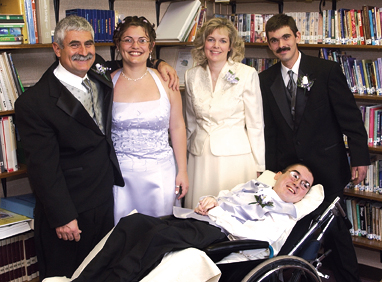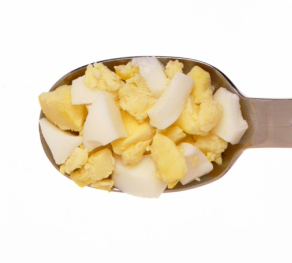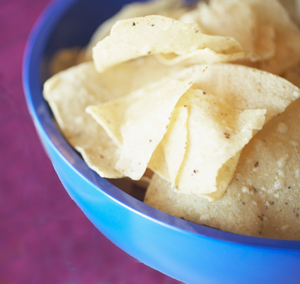
'I Can Eat That!' Cookbook for Easy Chewing and Swallowing
The mother of a man with SMA seeks to inspire others to modify favorite family recipes to accommodate a loved one's eating difficulties
Have you ever considered whether you eat to live or live to eat?
Food often holds a place of honor in our lives. Have you noticed how many events are accompanied by an element of food and drink? We have cake to celebrate birthdays and family reunion potluck picnics, as well as champagne toasts at a wedding.
 My late son Joe, who had spinal muscular atrophy type 1 (SMA), had chewing and swallowing difficulties that caused mealtime to be more of an aggravation than a joy for him. The desire for Joe to take pleasure in our family meals was the beginning of my pursuit to alter recipes and find ways to make mealtime a little more exciting for him.
My late son Joe, who had spinal muscular atrophy type 1 (SMA), had chewing and swallowing difficulties that caused mealtime to be more of an aggravation than a joy for him. The desire for Joe to take pleasure in our family meals was the beginning of my pursuit to alter recipes and find ways to make mealtime a little more exciting for him.
When Joe received his diagnosis at age 1, we were told he most likely would not live past age 2. But Joe hung in there, passing his second birthday and keeping right on going. As his fragile health situation progressed and his severe scoliosis became more pronounced, sitting upright was painful and restricted his breathing. Both of these conditions seriously impaired his ability to obtain adequate nutrition.
By the time Joe was 10 years old, he began to spend most of his time flat on his back in bed. Medical professionals were worried about Joe’s safety while eating in this position and recommended a feeding tube be inserted.
Although a feeding tube would make meals easier to manage, we felt less surgical intervention was more appropriate at that time. But as cook and caregiver, I recognized the difficulties Joe experienced in chewing and swallowing, as well as the very real dangers of choking and aspirating on food at each meal.
Initially, I attempted to alleviate Joe’s eating issues by choosing very soft foods and pureeing others. These methods probably would have solved the chewing and swallowing difficulty for some — but Joe didn't want his food to look any different than the rest of the family. He wanted to eat the same foods. Therefore, I began altering my everyday recipes around Joe’s abilities, instead of creating separate meals for him.
Joe, who died on April 10, 2008 at age 24, urged me to share my recipes and cooking methods with others experiencing similar mealtime dilemmas. In tribute and memory of him, I have compiled a 250-recipe solution to the question, “what can I eat?” — a cookbook titled I Can Eat That!
My hope is that it will inspire others to modify favorite family recipes to meet their loved ones’ individual requirements.
Here are a few strategies we employed:
- To ensure his dietary and caloric needs were being met, we requested a prescription from Joe’s physician for two cans of a nutritional supplement per day. (Joe experimented with different brands and determined which was easiest for him to swallow.) It’s important that your physician be aware of the addition of dietary supplements to your diet. Joe requested that he be wakened each morning about 8 a.m. to drink a can of the supplement, and he drank the other at 11 p.m. Then he would attempt to eat two full meals during the intervening hours. Joe ate lunch at about 1 p.m. and dinner at 6 p.m.
- Do not rush meal time! Generally, it took about two hours to feed Joe a meal since his muscles for chewing were weakened and he had limited jaw opening. Therefore, all
 bites were very small. He quickly adapted to eating room temperature meals. According to Joe, reheated food changed the texture and taste.
bites were very small. He quickly adapted to eating room temperature meals. According to Joe, reheated food changed the texture and taste. - Constipation is a persistent problem. Since Joe was unable to chew fresh fruit and vegetables, I found alternative ways to add them into his diet; such as putting fruits into smoothies and vegetables into soups. Smoothies (or any thick drink) needed to be thin enough to use a straw. Therefore, even though Joe loved strawberries, I added other seedless fruits so that he would be able to sip it, because even very small seeds can easily clog a straw. Another constipation remedy: We had good luck with Smooth Move tea from Traditional Medicinals, a licorice-flavored senna tea with laxative properties.
- Water, water, water. There is no substitution for a refreshing glass of water.
- A pitcher of sweetened iced tea was always in the refrigerator. If weight gain is an issue, experiment with natural ways to sweeten the tea. Sometimes I added a mint tea bag into the recipe and less sugar was needed.
- Whenever making something simple for Joe to chew (such as egg salad), I would enlist his assistance as my “taste tester.” It was a way to engage him in dinner preparations, as well as giving him a way to assist in making decisions. He would tell me if extra seasoning was needed, etc.
- Another mom gave me the idea of using new respiratory tubing (cut to the proper length) as a straw for drinking slightly-thickened smoothies and soups.
- Offer healthy small snacks continually. Joe needed additional calories throughout the day; therefore, I offered him cheese and crackers, creamy peanut butter on crackers, etc. Club crackers, Ritz crackers and saltines are good choices.
- Customize creatively. For example, Joe loved tacos but they became a little overwhelming to feed him. I started using the bite-sized or scoop-shaped tortilla chips and
 assembled mini tacos for him to enjoy. I added salsa directly into the prepared taco-flavored meat mixture. A small amount of cheese would be placed on the meat/salsa on top of the chip. Some may say this sounds like nachos. I maintain that Joe wanted to eat tacos, and I served him a meal with the ingredients of tacos in a presentation he could enjoy. By the way, white corn chips are easier to chew than yellow corn. Therefore, ordinary nachos became my customized mini tacos!
assembled mini tacos for him to enjoy. I added salsa directly into the prepared taco-flavored meat mixture. A small amount of cheese would be placed on the meat/salsa on top of the chip. Some may say this sounds like nachos. I maintain that Joe wanted to eat tacos, and I served him a meal with the ingredients of tacos in a presentation he could enjoy. By the way, white corn chips are easier to chew than yellow corn. Therefore, ordinary nachos became my customized mini tacos!
Freelance writer Debbie Button lives in Jarrettsville, Md. Her I Can Eat That! cookbook is available for $15 at www.debbiebutton.com/home or by calling (410) 879-7717 or writing her at 2748 Sharon Road, Jarrettsville, MD, 21084.
Try Some of My Recipes Below!
Note: These recipes also are available as a printable PDF. Cut out the 3x5 cards, and add them to your collection.
Cream of Potato Soup
This was Joe’s all-time favorite soup. The recipe was handed down from my Pennsylvania Dutch grandmother to my mother and then to me. What makes this soup different? We add in tiny dough-like dumplings called rivels. Delicious!
- 10-12 large potatoes, peeled, diced
- 3-4 stalks celery, finely chopped
- 2 medium onions, finely chopped
- 1 small can chicken broth
- 2 T. parsley flakes
- 8 T. butter
- 1 can evaporated milk
- Salt and pepper to taste
- 1 egg
- 1 cup flour
Directions
In large soup pot, cover potatoes, celery and onion with water (about 1-2 inches above). Boil until potatoes are tender. Do not drain. Using a large slotted spoon or potato masher, mash some of the potatoes against the side of the pot to thicken the soup. Add chicken broth, butter, parsley, and evaporated milk. Taste before adding salt and pepper. Over medium heat, bring temperature of soup to as warm as possible without boiling. At this point, stir together the egg and flour to make "dough." Crumble this mixture into the soup to make rivels. Turn heat very low and simmer for 30-60 minutes, stirring frequently.
Joe's Favorite Chicken Casserole
This often was Joe’s first choice for a dinner main course. This casserole may not have the eye appeal for a dinner party, but every bite is easy to chew and enjoy.
- 2 cups leftover cooked chicken (or turkey)
- 1 box stuffing mix, prepared according to package
- 1 can cream of chicken soup
- 1 can milk
- 2 cups broccoli florets (fresh is more tender than frozen)
- 2 T. parsley
Directions
Preheat oven to 350. Prepare stuffing mix according to package directions. In medium saucepan, whisk together soup and milk, then heat (do not boil). Combine ingredients in a 13x9x2-inch baking dish as follows: Place stuffing in center of pan in an oval shape. On outside of stuffing, line up broccoli around pan. Over the top of these, scatter cooked chicken. Over top, pour soup mixture spreading evenly to edges. Sprinkle with parsley. Cover with foil and bake for 30 minutes. Remove foil and bake for 15 minutes more.
MDA Resource Center: We’re Here For You
Our trained specialists are here to provide one-on-one support for every part of your journey. Send a message below or call us at 1-833-ASK-MDA1 (1-833-275-6321). If you live outside the U.S., we may be able to connect you to muscular dystrophy groups in your area, but MDA programs are only available in the U.S.
Request Information